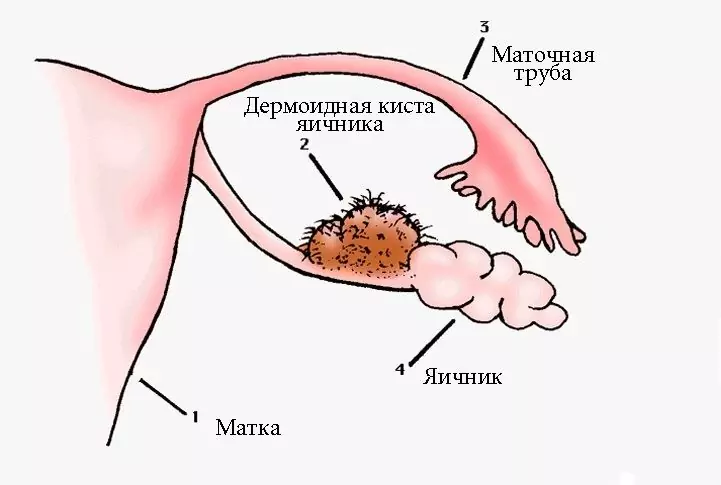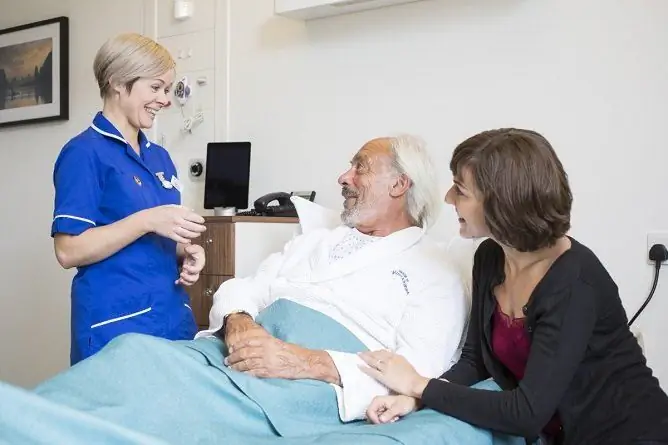- Author Rachel Wainwright [email protected].
- Public 2023-12-15 07:39.
- Last modified 2025-11-02 20:14.
Consequences of ischemic cerebral stroke
The content of the article:
- What determines the consequences of ischemic stroke
- What can be the consequences of ischemic stroke
- Stroke Signs and First Aid
- Treatment of ischemic stroke and its consequences
- Causes of stroke development, main forms of the disease and prevention
- Video
The consequences of ischemic stroke of the brain depend on which areas were involved in the process, as well as on the timeliness and adequacy of the assistance provided.
Stroke is an acute violation of cerebral circulation, which develops rapidly and leads to oxygen starvation of brain cells and their death. With a stroke, cerebral or focal neurological deficit is observed for more than a day. This pathology ranks first in the structure of the general mortality of the population. ICD-10 code - I63.
Most often, ischemic stroke is diagnosed, which is accompanied by cerebral infarction (softening of a piece of brain tissue).
Recovery after an ischemic stroke is the more effective the earlier it is started. If medical attention is given in the first three hours, the prognosis is generally good. The complex of rehabilitation measures makes it possible to reduce the risk of complications.

Ischemic stroke develops when blood flow suddenly stops in one of the cerebral vessels
What determines the consequences of ischemic stroke
Certain clinical signs of ischemic stroke depend on which parts of the brain are involved in the pathological process.
A stroke is characterized by sudden intense headache, dizziness, nausea and vomiting, throbbing of the cervical arteries, increasing weakness, loss of consciousness (up to the development of coma), a sharp drop in blood pressure, noisy breathing, bradycardia, pallor of the skin, numbness of the extremities, pain in the heart … The severity of symptoms in stroke depends on the extent of the lesion.
With a favorable variant of ischemic stroke, the patient's consciousness is restored after a few minutes, and then all brain functions are restored. Sometimes there is an intermittent course - consciousness returns to the patient after a few days or later, a significant part of the impaired brain functions is restored, however, relapses of the disease, the development of secondary pathologies are possible. There is also a progressive severe course, characterized by a steady increase in symptoms, often ends in death.
The consequences of an ischemic stroke of the brain, as a rule, cannot be completely avoided, however, it is possible to fully or partially restore the impaired functions when creating the necessary conditions for this.
Timely and correct diagnostics, immediate hospitalization of a patient with a stroke in a hospital, mandatory rehabilitation measures are of great importance. Thus, early (30-day) mortality of patients after stroke occurs in more than 40% of cases of treatment at home and in less than 25% of patients who were treated in a hospital.
The severity of the consequences of ischemic stroke depends on the extent and severity of the injury, as well as psychological and social factors. It is important that the patient is willing to take an active part in the recovery process, as well as the participation of others.
What can be the consequences of ischemic stroke
Complications of ischemic stroke can be:
- movement disorders - paresis, weakness, heaviness in the limbs, more often on one side of the body, violations of fine motor skills, facial expressions;
- decreased sensitivity in certain areas;
- speech disorders - slurred speech, inability to select the necessary words, impaired understanding of the speech of others, loss of speech;
- cognitive disorders - memory impairment, decreased attention, impaired reading and writing skills;
- visual disorders - blurred vision, loss of visual fields, diplopia;
- emotional disorders (depression is often observed).
A significant limitation of the patient's physical activity after a stroke can lead to the development of pressure sores, thrombosis, delayed bowel movements, the formation of contractures, and the occurrence of pneumonia.

The consequences, and most importantly, their reversibility, largely depend on how quickly assistance is provided for stroke.
About 20% of stroke patients develop a disability with the need for ongoing help from others. More than 55% of patients with acute cerebrovascular accidents remain able to work (some of them have limited working capacity). The ability to restore functions lost or impaired due to ischemic stroke depends on how damaged the brain is.
More serious complications of ischemic stroke develop in case of damage to functionally significant areas of the brain, extensive death of brain tissue, in elderly patients, with severe violations of the muscle tone of the limbs, and a decrease in the level of intelligence.
In addition, how serious the consequences of an ischemic stroke will be depends on the speed of care provided. Treatment is most effective in the first 3-6 hours. To get a patient to the hospital on time, you need to know the signs of a stroke.
Stroke Signs and First Aid
If you suspect a stroke, the patient may be asked to perform some actions (for example, close your eyes and stretch your arms out in front of you, palms up, raise both hands above your head, say a simple phrase, smile). So, in the presence of a stroke, the patient usually cannot raise his arms to the same height, he has speech defects, the smile turns out to be distorted. In this case, you should immediately call an ambulance and hospitalize the patient in a hospital.
If signs of a stroke are found before the arrival of the ambulance, it is recommended to place the patient so that his head is raised approximately 30 ° above the body level. A supply of fresh air should be provided - open the window, if necessary, loosen tight clothing (collar, belt, bra).
During the transportation of a patient with a stroke to the hospital, he is provided with the necessary medical assistance, which consists in normalizing blood pressure, restoring normal breathing, preventing the development of cerebral edema, seizures, etc.
Treatment of ischemic stroke and its consequences
Treatment of ischemic stroke after stabilization of the patient's condition is complex, including drug therapy, oxygen therapy, diet therapy, massage, passive and active therapeutic exercises, prevention of bedsores.
Therapy is aimed at restoring damaged functions and preventing the development of complications (pneumonia, infectious diseases of the urinary system, thrombus formation, etc.).
The disease requires mandatory rehabilitation measures, which increases the ability to avoid relapses of pathology. Rehabilitation measures begin from the moment the patient's life is out of danger. Rehabilitation is possible both at home and in specialized centers. If there is no way to provide continuous care at home, it is recommended to give preference to the latter.
Regardless of where the rehabilitation takes place, its plan is selected for each patient individually, it requires strict adherence to all prescriptions and daily work to restore the lost functions.
An adequate rehabilitation program and lifestyle correction allow eliminating the complications of ischemic stroke with maximum speed and efficiency.
Causes of stroke development, main forms of the disease and prevention
Risk factors for stroke include age over 50 years, the presence of arterial hypertension, atherosclerosis, diabetes mellitus, chronic heart disease, transient ischemic attacks, as well as overweight, smoking, alcohol abuse, occupational hazards, genetic predisposition. Stroke is more common in men.
There are two main forms of stroke: ischemic and hemorrhagic. Ischemic stroke is most often recorded (in 70-85% of patients). With this form of the disease, a blood vessel is blocked, as a result of which it ceases to perform its functions and the blood supply to the area that it feeds stops. This first causes acute oxygen starvation of brain cells, and subsequently their death. The size of the affected area depends on how large the affected vessel is.

The consequences of a stroke are disorders of the motor and sensory function of the nerves on the side opposite to the lesion.
With the hemorrhagic form of the disease, a blood vessel ruptures, as a result of which not only a certain area of the brain is no longer supplied with blood, but also blood flows into the brain, into the ventricles or under the meninges. This type of acute cerebrovascular accident is more severe, has more severe consequences and is more often fatal.
Depending on the mechanism of development, ischemic stroke is divided into cardioembolic (with arrhythmias, endocarditis, heart defects), atherothromboembolic (with atherosclerosis of large arteries), lacunar (ischemia occurs when a small blood vessel is blocked), as well as stroke of another and unknown etiology.
Ischemic stroke on the left side of the brain is more common than on the right side - stroke of the left hemisphere accounts for about 57% of the total number of reported cases. With this form of pathology, patients have motor and sensory disorders of the right side of the body, in addition, disorders of speech, reading and writing skills often develop, and the patient's communication with others may be limited.
Ischemic stroke on the right side of the brain usually does not manifest with speech abnormalities (in left-handed people, they can occur). According to a number of studies, in stroke of the right hemisphere, the diagnosis is often made later in comparison with damage to the left side of the brain, in which speech impairments are usually present.
In order to prevent the development of a stroke, a balanced diet, adequate night's sleep, correction of excess weight, adequate physical activity, rejection of bad habits, avoidance of stress, timely treatment of diseases are recommended, the complication of which may be acute cerebrovascular accident.
Video
We offer for viewing a video on the topic of the article.

Anna Aksenova Medical journalist About the author
Education: 2004-2007 "First Kiev Medical College" specialty "Laboratory Diagnostics".
Found a mistake in the text? Select it and press Ctrl + Enter.






